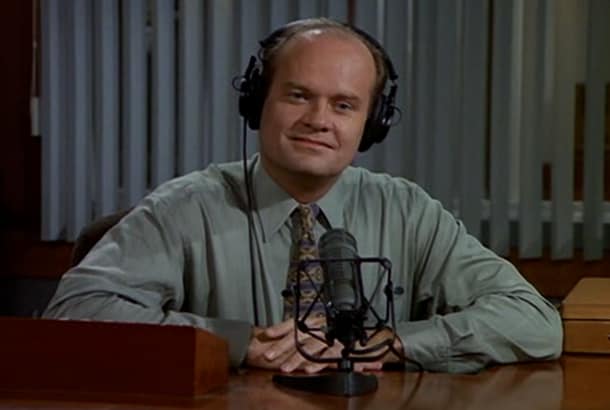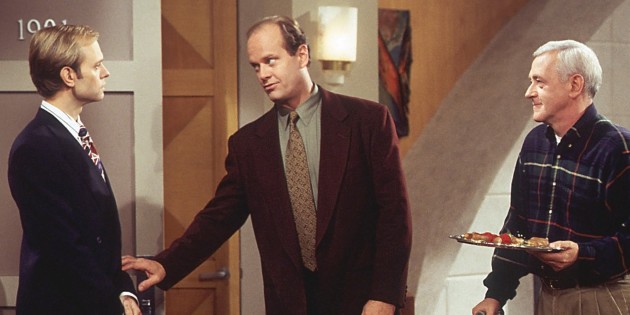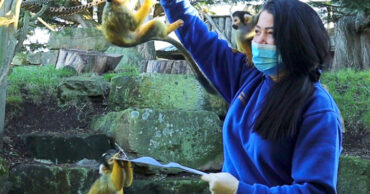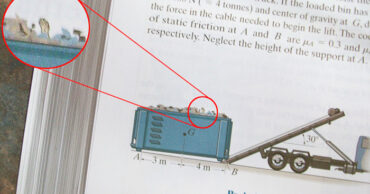
Like any long-running television show, Frasier‘s later seasons are marked by shallow characterizations and repetitive storytelling, a classic case of creative exhaustion any popular, lasting show has dealt with. And with that creative exhaustion comes an increasing reliance on old narrative devices and tricks, desperate attempts to recapture old magic that never works: Friends did it with repeated Ross/Rachel stories and increasingly-awful flashbacks, Cheers did it with Rebecca and Sam, 24 with moles and last-second plot twists… and Frasier did it with farce, turning a once-wonderful bit of old-school presentation into head-shakingly awful slapstick that became more and more common place with each growing season.
Early on, Frasier was a multi-camera comedy aspiring to be something different: an intelligent show, one that contemplated the theoretical debates of psychology and explored the mid-life crisis of Frasier Crane with a focus on character that most other shows wouldn’t attempt – both of its time, and in the genre as a whole. However, episodes like season two’s “The Innkeepers” and season three’s “Look Before You Leap” showed a completely different type of Frasier: one driven by farce, playing off the irony of the two uptight, well-kept Crane brothers and their inability to handle chaos in any way, shape or form. In “The Innkeepers”, the pair try to open a restaurant to disastrous results; in season three’s “Police Story”, Frasier ends up sharing the intimiate details (or lack thereof) of his personal life unknowingly in front of everyone working at the radio station; in its first few seasons, Frasier‘s slapstick routines were played to underline the seriousness of the show’s more contemplative episodes and ideas, like the season one finale “My Coffee with Niles”, or season three’s overarching theme of loneliness.
As Frasier crossed the 50-episode mark and started working its way to the centennial mark, its once-entertaining use of farce began to show its strain. As early as season four, Frasier began to use ironic situations and silliness a little too often for its own good: “Four For the Seesaw” tries to draw laughs repeatedly from the same joke of missed communication, and “To Kill a Talking Bird” is an extended joke about hiding a parrot at a dinner party, to increasingly unfunny results. The tide hadn’t completely turned on Frasier – season four also contains all-time classics like “Death and the Dog” and “The Unnatural”, the latter which uses farce to reveal Frasier’s shame about being a flawed parent – but that season proved to be a turning point for the show’s favorite narrative device.

The problem with Frasier‘s increasing reliance on irony and slapstick in later seasons comes with how out-of-tone it felt for the show: as broad as the show went with jokes about Frasier’s need for expensive, pointless things or Niles’ mysophobia, Frasier always had a grip on the emotions and intelligence of its main characters. However, slapstick undermines the very foundations of intelligent, measured comedy – and as seasons five through ten proved, it eventually leads to a much-lesser show, reducing characters to a few well-worn bits of personality for more stories where miscommunications lead to hijinks (like Marty’s hair polish in season five’s “The Life of the Party”, or when Niles and Lilith sleep together in “Room Service” earlier that season).
There are certainly moments when Frasier avoided these repetitive story lines – season six’s first few episodes are a notable example, where Frasier comes to terms with getting fired and not being able to find a new position on television or private practice. But large stories on the show are ultimately undermined by the show’s lackadaisical approach to unique narrative construction, most of all Niles and Daphne’s relationship and later engagement, which was a lot of ridiculous stories that made audiences wonder whether they really should be a couple or not. Thankfully, the show backed away from things a bit in its touching, return-to-form eleventh – and final – season (though it wasn’t completely free of it, thanks to episodes like “The Ann Who Came to Dinner”), but its legacy still remains tarnished by those middle seasons, plagued with memories of bug-eyed Frasier Crane running around to canned audience laughter.
Photos via NBC
 Follow Us
Follow Us






Why would anyone write about a show that has been done for 10 years? I liked Frasier. Some of the shows you mention I thought were really funny. The ones I didn’t care for was when the radio crew was laid off and Frasier had to start his own private practice. It became monotonous without the slapstlick humor.
Good article-good insight